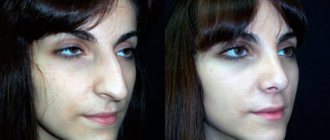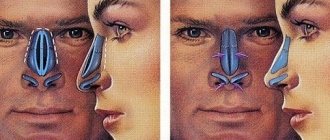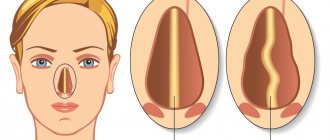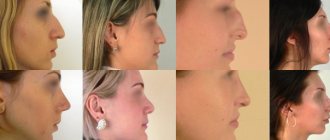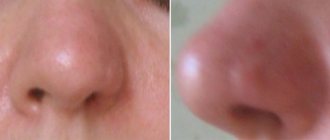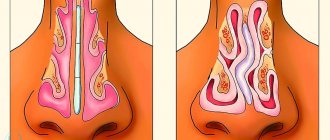PLANNING NOSE SHAPE CORRECTION SURGERY
Before the operation, the surgeon always carefully analyzes the shape and structure of the nose and explains what changes are possible in each specific case, as well as what factors may affect the operation and its final result.
These factors include the structure of the nasal bones and cartilage, the shape of the face, the thickness of the skin, and age.
The surgeon draws up the operation plan taking into account all known circumstances and develops it to the smallest detail.
To analyze the existing defect before treatment and during surgical treatment, a series of photographs will be taken. If the patient has previously had any surgery or trauma to the nose, has allergies or difficulty breathing, he must be informed about this at the consultation.
Issues related to smoking and taking medications should be specifically addressed.
The patient must prepare for any operation, not just rhinoplasty. The surgeon gives recommendations for the preparation period. If any questions arise, it is imperative to discuss them before the operation.
CARRYING OUT THE OPERATION
Rhinoplasty is performed only in a hospital setting under general anesthesia. The duration of the operation is usually 1.5-2 hours, although more complex procedures may take longer.
Rhinoplasty can be cartilaginous or osteochondral. It is carried out using two methods: open (a small incision is made under the nose) and closed (the incision is made on the inside of the nostrils).
The operation consists of separating the skin of the nose from the bones and cartilage, which will be brought to the desired shape. After this, the skin is restored. The hospital stay is usually 1-3 days, depending on the extent of the surgical intervention.
USE OF LOW-TRAUMATIC ULTRASONIC PIEZO TECHNOLOGY
When choosing low-traumatic technologies in rhinoplasty, it is assumed to use a modern Piezo device, which is capable of quickly and accurately grinding and cutting off the bones inside the nose.
The operation uses ultrasound with cooling. The frequency of the device is such that it affects only dense tissues without damaging their soft counterparts and vessels, which eliminates bleeding.
Over the past year, the Charm Clinic has been actively using ultrasound technology using the Piezo apparatus in rhinoplasty operations.
POSTOPERATIVE PERIOD AFTER NOSE PLASTY
To stop bleeding after surgery, gauze turundas are inserted into the nose, which are removed after a day, during which the patient breathes through the mouth. After the operation, a plaster cast is applied to the face, which is removed after 8-10 days.
The first dressing is done the next day after the operation. Swelling is often observed, and sometimes, more rarely, a change in skin color (bruising) around the eyes, which disappears in most cases within two weeks.
Tissue swelling completely disappears over a longer period (from 6 months to a year). The time when the patient can return to his daily activities is determined by his well-being. This usually becomes possible within 7-10 days after surgery.
To quickly restore nasal tissue (reduce swelling, restore skin sensitivity, eliminate nasal congestion), it is recommended to carry out physiotherapeutic procedures (FA, UHF, electrophoresis, ultrasound) throughout the year (3-4 courses).
It is also advisable to see your doctor. Preliminary results of the operation can be assessed after 14 days, final results - after 1-1.5 years.
Rhinoplasty
One of the most popular types of plastic surgery is nose correction (rhinoplasty). Indeed, an insufficiently aesthetic size or shape of the nose can cause psychological discomfort. The aesthetics of the nose greatly influences the overall facial expression: it can make it look rustic, arrogant, dejected - and these traits are not necessarily inherent in a person. Rhinoplasty is one of the most common and at the same time most complex types of plastic surgery; the surgeon performing such an operation must be a top-class specialist and, moreover, not only a theorist, but also an experienced practitioner in otolaryngology.
What problems can rhinoplasty solve?
- Get rid of the “hump”;
- Adjust the length of the nose;
- Reduce the width of the nose;
- Align the bridge of the nose;
- Raise and reduce the tip;
- Eliminate asymmetry of the wings of the nose;
- Change the size of the nostrils;
- Change the angle between the lips and the tip of the nose, etc.
Types of rhinoplasty
Today, there are two main methods of surgical correction of the nose:
- Closed: the doctor makes incisions in the inner area of the nostrils;
- Open: The surgeon makes an external incision in the skin of the nasal septum; in some cases, it may also be necessary to make one incision at the base of each nostril.
The closed method leaves no visible marks at all, while the open method leaves the finest whitish stripes. Our clinic bases its work on the use of advanced medical technologies, modern transplantation materials, and unique therapeutic complexes, which ensures a high level of plastic surgery.
Stages
- Consultation with a plastic surgeon.
- Preparation period.
- Carrying out the operation.
- Rehabilitation.
Preparing for surgery
The first thing you need to do is get an appointment with a competent and highly qualified surgeon. The surgeon performing such an operation must be a high-class specialist and, moreover, not only a theorist, but also an experienced practitioner in otolaryngology. He will determine the plan and prescribe the necessary tests, and give recommendations on preoperative preparation. On average, this period is 1 week, and once the tests are ready, the day of surgery is scheduled.
Method of performing rhinoplasty
The operation is performed under both local and general anesthesia. The method of anesthesia is agreed upon between the patient and the plastic surgeon. It depends on the complexity of the operation, as well as the individual characteristics of the patient and his wishes.
Special advantage of rhinoplasty
Rhinoplasty not only improves the aesthetic appearance of the nose, but also restores nasal breathing by correcting the nasal septum.
Price issue
Payment for the operation depends on a number of factors: the method of pain relief, the type of incision, the need for reconstruction of the nasal septum and modeling of bone tissue, the number of days in the clinic. Only after assessing all these factors is it decided how much rhinoplasty for a particular patient costs. Fortunately, advances in technology are making this procedure increasingly accessible.
In the case of correction of defects from previous interventions, the operation is longer and more complex, so prices for revision rhinoplasty are always higher.
Pros of rhinoplasty
- The ability to get rid of complexes. It becomes easier to communicate in large companies, and the dislike for the camera disappears.
- People around you may often not notice obvious changes after surgery, but they note a significantly increased attractiveness of the person. For example, a nose that is too long makes the face look dull and despondent. Tip rhinoplasty can easily cope with this.
- Restoring nasal breathing reduces the possibility of getting sick, colds are easier and have fewer complications in the bronchi and lungs.
- A nose after rhinoplasty makes the face not only more pleasant, but also youthful. The reason is that over time the tissues sag somewhat, which immediately adds years to the appearance; surgery eliminates these changes.
Is rhinoplasty suitable for everyone?
Rhinoplasty is a complex and responsible surgical operation, performed using anesthesia and, naturally, is not indifferent to the body. Therefore, it has its own contraindications:
- Age. For correcting your appearance, the ideal life span is from 18 to 40 years. In very young people, the bones and cartilage are not fully developed, so the final result may become somewhat unexpected over time. In adulthood, tissues become rigid, healing progresses worse, and acquired diseases increase surgical risk. This restriction does not apply to traumatic injuries to the nose; here rhinoplasty should be done as early as possible.
- Serious acute or chronic diseases, especially diabetes mellitus, oncology, cardiac pathology, renal or liver failure, blood clotting disorders. For acute viral or bacterial infections, surgery is postponed until recovery. Also, the intervention is not carried out if acne or herpetic rashes appear on the nose or the surrounding skin of the nose.
- Too frequent visits from a patient to a plastic surgeon and new reasons for dissatisfaction with one’s appearance may lead one to suspect dysmorphophobia. This syndrome forces people to constantly change themselves, again remaining dissatisfied with the result obtained. In such cases, a consultation with a psychologist and psychotherapist is first necessary.
Attention! The operation is underway!
First, a marker is used - it outlines the main changes planned by the surgeon. Sometimes they are limited to changes in soft tissues, the size of the cartilage often decreases, and with pronounced humps, excess bone is cut off. If it is necessary to lift the bridge of the nose, you may need your own graft - cartilage from the auricle or a piece of bone, you can use silicone inserts. The amount of rhinoplasty for a given patient depends on the scope of the operation and the materials used.
Depending on the complexity, open or closed access is possible. If closed rhinoplasty is chosen, surgeons work inside the nose through the nostrils, the incisions are not noticeable, and there are no scars left on the outside. But manipulations in a narrow field and with limited vision control reduce the doctor’s capabilities.
In such cases, an additional incision is made in the skin pedicle between the nostrils (columella), sometimes in combination with an incision along the edge - open access. The cosmetic seam remains almost invisible. For repeated operations, preference is also given to the open method.
Indications for rhinoplasty
- Aesthetic dissatisfaction:
- A pronounced hump on the bridge of the nose.
- Nostrils that are too wide or large.
- The tip of the nose is curved downwards or thickened.
- Saddle-shaped nose due to the receding back.
- Excessive length.
- Congenital defects - asymmetry of bones, their underdevelopment: “cleft lip”, “cleft palate”
- Acquired injuries - fractures and deformations in the early and late period after injury.
- Impaired nasal breathing associated with a deviated septum and enlarged nasal turbinates.
Is rhinoplasty very painful?
The degree of sensation directly during surgery depends on the method of anesthesia. During general anesthesia, the patient sleeps and does not feel anything. If local anesthesia is chosen, there will be no pain, but the sensations and sounds of working on the bone may cause discomfort.
The first few days are inconvenient because you have to breathe through your mouth; it dries out the oral mucosa, but you have to be patient until the tampons are removed from your nose.
Swelling and bruising necessarily accompany rhinoplasty, especially if the doctor worked with bone. But they go away within a few days, residual swelling can persist for a long time, but it practically does not affect the appearance.
A moderate increase in body temperature may be observed; during the period of recovery from anesthesia, there may be weakness and a desire to sleep more. You need to submit to your body and spend the first days in bed.
Cons of nose surgery
Rhinoplasty of the nose is very important, but changing your appearance will not solve all problems, nor will it replace the need to act and develop. After the operation, life around you will not immediately become fabulous and easy.
The operating surgeon, in pursuit of ideal forms, must not forget about the correct internal relationships, otherwise the nose will breathe poorly and there may be problems with the sense of smell. The desire to achieve a “chiseled” nose can lead to a recessed back.
The first time after the intervention is not the most pleasant feeling. Bruises under the eyes, swelling after rhinoplasty, crusting and dry nose can ruin your mood for several days. And the need to breathe through the mouth until the tampons are removed makes it difficult to sleep and eat.
Getting ready for surgery
- First you need to decide on a doctor; a very important criterion is complete trust in the opinion of a professional. Rhinoplasty is planned - reviews of people who have undergone this operation will help you choose the right clinic and surgeon
- It is important to undergo an examination, pass all tests and make sure that there are no contraindications.
- Together with the surgeon, you need to look at intervention options and evaluate the possible result using special computer modeling programs. At this stage, you can decide whether to do rhinoplasty at all, and how serious changes need to be made.
- The method of pain relief is determined - local or general, and tests are carried out for allergies to drugs. The type of anesthesia is selected depending on the psychological mood, characteristics of the patient’s nervous system and the severity of the operation. For example, plastic surgery of the tip of the nose does not require deep and long-term anesthesia.
- For women, it is important to choose the right time for surgery, taking into account the menstrual cycle.

